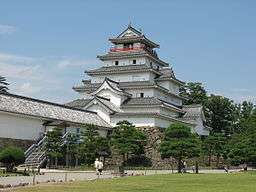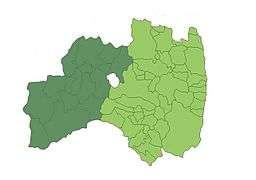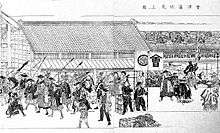Aizu
| Aizu (会津) | |
| Region | |
 Tsuruga Castle, located in Aizuwakamatsu | |
| Country | Japan |
|---|---|
| Prefecture | Fukushima |
| Area | 5,420.69 km2 (2,093 sq mi) |
| Population | 291,838 (1 October 2010) |
| Density | 54/km2 (140/sq mi) |
 Aizu comprises the western third of Fukushima Prefecture
| |
Aizu (会津 Aizu) is the westernmost of the three regions of Fukushima Prefecture in Japan, the other two regions being Nakadōri in the central area of the prefecture and Hamadōri in the east. As of October 1, 2010, it had a population of 291,838.[1] The principal city of the area is Aizuwakamatsu.
During the Edo period, Aizu was a feudal domain known as Aizu Domain (会津藩 Aizu-han).[2] It was part of Mutsu Province; the area once was part of Iwase Province in the 8th century and, before the prefectural system, Iwashiro Province. Although never an official province in its own right, Aizu was considered as such de facto, and even today local Japan Rail stations prefix "Aizu-" to names instead of "Iwashiro-", as it was for stations around the center of Fukushima Prefecture.
History

The daimyo over much of the Edo period was from the Hoshina family. They had been senior retainers of the Takeda family, and in the early 17th century the head of the family, Hoshina Masamitsu, adopted the illegitimate son of the second Tokugawa shogun Hidetada. As a result, the Hoshina family's fortunes rose, with larger and larger fiefs being given to them, until finally they were moved to Aizu, then rated at 240,000 koku, in the mid-17th century. Hoshina Masayuki, the adopted head of the family, rose in prominence while his half-brother Tokugawa Iemitsu was shogun, and later acted as a regent for his successor, the underage fourth shogun Tokugawa Ietsuna. By the end of the 17th century, the Hoshina family was allowed the use of the Tokugawa hollyhock crest and the Matsudaira surname, and from then on was known as the Aizu-Matsudaira clan, with the name Hoshina being used mainly for internal documents.
In 1822, the Hoshina-Matsudaira line became extinct with the death of the seventh lord Katahiro, at the age of only 15. He was succeeded by the eighth lord Katataka, who was a sixth cousin (twice removed) and a member of the Takasu cadet branch of the Mito collateral line. He died without heirs in 1852 and was succeeded by his grandnephew, the famous Katamori, whose descendants have since headed the family. The present head of the Tokugawa clan, Tsunenari, is also from the Aizu lineage.
In the house code set down by Masayuki, there was a specific injunction to serve the shogun with single-minded devotion, and it was this injunction which the family took great pains to show its adherence to, even if its true objectives were those of improving status and prestige.
Aizu was known for its martial skill, and maintained a standing army of over 5000. It was often deployed to security operations on the northern fringes of the country, as far north as southern Sakhalin. Also, around the time of Commodore Perry's arrival, Aizu had a presence in security operations around Edo Bay.
The domain's two sets of formal rules for its army, the Rules for Commanders (将長禁令 shōchō kinrei) and Rules for Soldiers (士卒禁令 shisotsu kinrei), written in the 1790s, laid down a professional, modern standard for military conduct and operations, including the following two items in the Rules for Soldiers which codified the human rights and protection of enemy noncombatants, over 70 years before the first Geneva Convention of 1864:

- 敵地といえども猥りに田畑を踏荒らすべからざる事。
"Regardless of whether it belongs to the enemy, trampling and ruining rice fields is forbidden."
- 敵地に入って、婦女を犯し、老幼を害し、墳墓を荒らし、民家を焼き、猥りに畜類を殺し、米金を掠取り、故なく林木を伐り、作毛を刈取べからざる事。
"In enemy territory, it is forbidden to rape women, harm the elderly and children, desecrate graves, torch the homes of commoners, slaughter livestock needlessly, pillage money and rice, cut trees without reason, and steal crops in the field."
During the tenure of the ninth generation lord Matsudaira Katamori, the domain deployed massive amounts of their troops to Kyoto, where Katamori served as Kyoto Shugoshoku. Operating under the orders of the Shogunate, they also acted as the first official supervisor and patron of the Shinsengumi. Earning the enmity of the Chōshū Domain, and alienating his ally, the Satsuma Domain, Katamori retreated with the shogun Tokugawa Yoshinobu in 1868. Though the Satsuma-Chōshū controlled Imperial Court, following Yoshinobu's resignation, called for the punishment of Katamori and Aizu as "enemies of the Court," he took great pains to beg for mercy, finally acquiescing to calls for war later in 1868, during the Boshin War. Though the Aizu forces fought as part of the greater efforts of the Ōuetsu Reppan Dōmei, they were eventually besieged at Tsuruga Castle, the seat of the Aizu domain, in October 1868.
The Byakkotai ("White Tiger Force"), a group of young, predominantly teenage, samurai, committed seppuku (a form of ritual suicide) on a hillside overlooking the castle after seeing its defences breached.
Notable people
- Dewa Shigetō (1856–1930), an admiral of the Imperial Japanese Navy, elevated to the peerage with the title of danshaku (baron).
- Hideyo Noguchi (1876–1928), a doctor who made considerable contributions to the fight against syphilis and yellow fever.
- Shiba Gorō (1860–1945), prominent at the Siege of the Peking legations, 1900.
- Niijima Yae (born: Yamamoto Yaeko, 1845–1932), female warrior, co-founder of Doshisha University, instructor in the women's division of Doshisha and wife of Niijima Jo (Joseph Hardy Neesima), nurse, tea master
- Yamamoto Kakuma (1828–1892), former samurai, co-founder of Doshisha University.
- Takamine Hideo (1854–1910), former samurai, graduate of Oswego Normal School in New York State, Meiji-era educator and head of the Tokyo Normal School, Tokyo Art School, Tokyo Women's Normal School and Tokyo Music School. He is best known for introducing Pestallozian teaching methods to Japan and educational reform.
- Ibuka Kajinosuke (1854–1935), former samurai turned Christian pastor, responsible for bringing the YMCA to Japan.
- Matsudaira Tsuneo (1877–1949), son of Matsudaira Katamori, ambassador to the U.S. and UK.
- Matsudaira Setsuko (1909–1995), daughter of Matsudaira Tsuneo; later married Prince Chichibu no Miya, Emperor Hirohito's brother.
- Yamakawa Kenjirō (1854–1931), graduate of Yale University, physicist, researcher, academic administrator, President of Tokyo University and Kyoto University
- Yamakawa Sutematsu (1860–1919) graduate of Vassar College, after marriage to Oyama Iwao, she is known as Oyama Sutematsu, an organizer at the Rokumeikan, supporter of numerous organizations such as the Red-Cross in Japan and Women's Patriotic Society. She assisted in the founding of Tsuda College (which was organized by her close lifelong friend Tsuda Umeko)
- Yamakawa Hiroshi (1845–1898) Brother of Kenjiro and Sutematsu, a notable military leader who defended the domain, later organized Aizu refugees, a key figure in the relief of Kumamoto Garrison during the Seinan War or Satsuma Rebellion and General in the Meiji Era
- Yamakawa Futaba (1844–1909), a co-worker of Takamine Hideo, head administrator at the Tokyo Women's Normal School, she is best known for her support of women's education
- Tokugawa Tsunenari (1940 – ), grandson of Matsudaira Tsuneo; current head of the main Tokugawa family.
- Saigō Tanomo (1830–1903), former chief councilor of the Aizu clan; later, a teacher of Sokaku Takeda and a chief priest of the Toshogu Shrine.
- Akabane Shirō (赤羽四郎) (1855–1910), Japanese ambassador to Holland.
- Akazuka Takemori (赤塚武盛) (1852–1879), Meiji-era police official.[3]
- Uryu Iwako (1829–1897), prominent social worker.
- Suwa Kichiko (1819–1907), philanthropist.
- Yūki Kunitari (1800–1888), poet.
- Matsudaira Isao (松平勇雄) (1907–2006), grandson of Katamori, politician, governor of Fukushima Prefecture (1976–1988).
- Akizuki Teijirō (1824–1900), Aizu samurai, educator.
- Kiyoshi Saitō (1907–1997), sōsaku hanga artist.
- Nakano Takeko (1847–1868), female warrior.
- Kei Sato (1928–2010), film actor
List of Aizu daimyo
| Name | Tenure |
|---|---|
| Gamō Ujisato (蒲生氏郷) | 1590–1595 |
| Gamō Hideyuki (蒲生秀行) | 1595–1598 |
- Uesugi clan 1598-1601 (Tozama; 1,200,000 koku)
| Name | Tenure |
|---|---|
| Uesugi Kagekatsu (上杉景勝) | 1598–1601 |
- Gamō clan 1601-1627 (Tozama; 600,000 koku)
| Name | Tenure |
|---|---|
| Gamō Hideyuki (蒲生秀行) | 1601–1612 |
| Gamō Tadasato (蒲生忠郷) | 1612–1627 |
- Katō clan 1627-1643 (Tozama; 400,000 koku)
| Name | Tenure |
|---|---|
| Katō Yoshiaki (加藤嘉明) | 1627–1631 |
| Katō Akinari (加藤明成) | 1631–1643 |
-
 Hoshina/Matsudaira clan 1643-1868 (Shinpan; 230,000->280,000 koku)
Hoshina/Matsudaira clan 1643-1868 (Shinpan; 230,000->280,000 koku)
| Name | Tenure |
|---|---|
| Hoshina Masayuki (保科正之) | 1643–1669 |
| Hoshina Masatsune (保科正経) | 1669–1681 |
| Matsudaira Masakata (松平正容) | 1681–1731 |
| Matsudaira Katasada (松平容貞) | 1731–1750 |
| Matsudaira Katanobu (松平容頌) | 1750–1805 |
| Matsudaira Kataoki (松平容住) | 1805 |
| Matsudaira Katahiro (松平容衆) | 1806–1822 |
| Matsudaira Katataka (松平容敬) | 1822–1852 |
| Matsudaira Katamori (松平容保) | 1852–1868 |
| Matsudaira Nobunori (松平喜徳) | 1868 - 1891 |
Genealogy (Hoshina-Matsudaira line)
 Tokugawa Ieyasu, 1st Tokugawa Shōgun (1543-1616; r. 1603-1605)
Tokugawa Ieyasu, 1st Tokugawa Shōgun (1543-1616; r. 1603-1605)
 Tokugawa Hidetada, 2nd Tokugawa Shōgun (1579-1632; r. 1605-1623)
Tokugawa Hidetada, 2nd Tokugawa Shōgun (1579-1632; r. 1605-1623)
 I. Hoshina Masayuki, 1st Lord of Aizu (cr. 1643) (1611-1673; r. 1643-1669)
I. Hoshina Masayuki, 1st Lord of Aizu (cr. 1643) (1611-1673; r. 1643-1669)
 II. Hoshina Masatsune, 2nd Lord of Aizu (1647-1681; r. 1669-1681)
II. Hoshina Masatsune, 2nd Lord of Aizu (1647-1681; r. 1669-1681) III. Matsudaira Masakata, 3rd Lord of Aizu (1669-1731; r. 1681-1731)
III. Matsudaira Masakata, 3rd Lord of Aizu (1669-1731; r. 1681-1731)
 IV. Katasada, 4th Lord of Aizu (1724-1750; r. 1731-1750)
IV. Katasada, 4th Lord of Aizu (1724-1750; r. 1731-1750)
-
 V. Katanobu, 5th Lord of Aizu (1744-1805; r. 1750-1805)
V. Katanobu, 5th Lord of Aizu (1744-1805; r. 1750-1805)
-
- Hirofumi
- Kataaki (1750-1785)
-
 VI. Kataoki, 6th Lord of Aizu (1779-1806; r. 1805)
VI. Kataoki, 6th Lord of Aizu (1779-1806; r. 1805)
-
 VII. Katahiro, 7th Lord of Aizu (1803-1822; r. 1806-1822)
VII. Katahiro, 7th Lord of Aizu (1803-1822; r. 1806-1822)
-
-
- Kataaki (1750-1785)
- Tokugawa Yorifusa, 1st Lord of Mito (1603-1661)
- Yorishige, 1st Lord of Takamatsu (1622-1695)
- Yoritoshi (1661-1687)
- Yoritoyo, 3rd Lord of Takamatsu (1680-1735)
- Tokugawa Munetaka, 4th Lord of Mito (1705-1730)
- Tokugawa Munemoto, 5th Lord of Mito (1728-1766)
- Tokugawa Harumori, 6th Lord of Mito (1751-1805)
- Tokugawa Harutoshi, 7th Lord of Mito (1773-1816)
- Tokugawa Nariaki, 9th Lord of Mito (1800-1860)
-
 X. Nobunori, 10th Lord of Aizu, 10th family head, Viscount (1855-1891; Lord: 1868; Viscount: cr. 1884)
X. Nobunori, 10th Lord of Aizu, 10th family head, Viscount (1855-1891; Lord: 1868; Viscount: cr. 1884)
-
- Tokugawa Nariaki, 9th Lord of Mito (1800-1860)
- Yoshikazu, 9th Lord of Takasu (1776-1832)
- Yoshitatsu, 10th Lord of Takasu (1800-1862)
 IX. Katamori, 9th Lord of Aizu (1836-1893; r. 1852-1868)
IX. Katamori, 9th Lord of Aizu (1836-1893; r. 1852-1868)
- Kataharu, 11th family head, 1st Viscount (1869-1910; 11th family head: 1869-1910; Viscount: cr. 1884)
- Rear-Admiral Morio, 12th family head, 2nd Viscount (1878-1944; 12th family head and 2nd Viscount: 1910-1944)
- Moritei, 13th family head, 3rd Viscount (1926-2011; 13th family head: 1944-2011; 3rd Viscount: 1944-1947)
- Yasuhisa, 14th family head (b. 1954; 14th family head: 2011- )
- Moritei, 13th family head, 3rd Viscount (1926-2011; 13th family head: 1944-2011; 3rd Viscount: 1944-1947)
-
 VIII. Katataka, 8th Lord of Aizu (1806-1852; r. 1822-1852)
VIII. Katataka, 8th Lord of Aizu (1806-1852; r. 1822-1852)
- Yoshitatsu, 10th Lord of Takasu (1800-1862)
- Tokugawa Harutoshi, 7th Lord of Mito (1773-1816)
- Tokugawa Harumori, 6th Lord of Mito (1751-1805)
- Tokugawa Munemoto, 5th Lord of Mito (1728-1766)
- Tokugawa Munetaka, 4th Lord of Mito (1705-1730)
- Yoritoyo, 3rd Lord of Takamatsu (1680-1735)
- Yoritoshi (1661-1687)
- Yorishige, 1st Lord of Takamatsu (1622-1695)
See also
Notes

- ↑ 福島県企画調整部総計調査課 (27 December 2010). 平成22年国勢調査速報-福島県の人口・世帯数- (in Japanese). Fukushima Prefecture. Retrieved 3 May 2012.
- ↑ Deal, William E. (2005). Handbook to Life in Medieval and Early Modern Japan, p. 81.
- ↑ 会津人物事典
- ↑ Genealogy (jp)
References
- Noguchi Shinichi, Aizu-han. Tokyo: Gendai Shokan, 2005. (ISBN 4-7684-7102-1)
- Bolitho, Harold. “Aizu, 1853-1868.” Proceedings of the British Association for Japanese Studies, vol. 2 (1977): 1-17.
External links
![]() Media related to Aizu Clan Parade at Wikimedia Commons
Media related to Aizu Clan Parade at Wikimedia Commons

